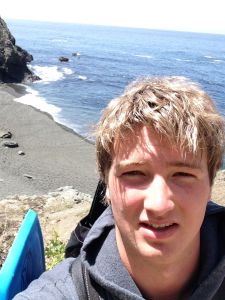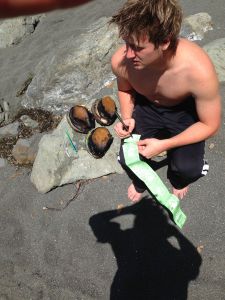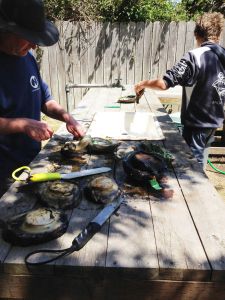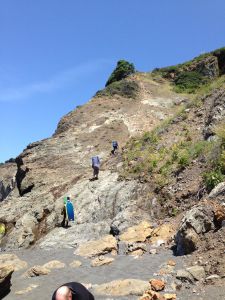Pushing himself further underwater with every kick of his flippers, junior Chris O’Day prepares to cut an abalone off a rock.

“The light is really bad,” O’Day said. “At 25 feet, the pressure is really strong. You can definitely feel it. If you were to get stuck in the kelp or something, you would be in trouble very quickly.”
As the abalone season gets underway, O’Day often goes on abalone diving trips with his family and close friends.
O’Day travels three hours to Elk, a small town up the north coast, where he dives with four or five other families. The group typically stays at a campsite nearby.
“You usually have to hike down some sort of cliff or path to get to the beach,” O’Day said. “Once you’re down there, you put on your gear, which is a thick wetsuit, a wake belt, fins, a mask, gloves, booties, you need everything to protect you from the cold. It’s about 55 degrees, I think, so quite cold.”
In order to dive for abalone, O’Day must swim about a half a mile out to the kelp in a thick suit which limits mobility.
Once out in the water, O’Day must locate the abalone.
“The visibility in the water on a good day is ten feet, so you can’t see the bottom when you’re going because the abalone are at least fifteen feet out, more like 25 feet,” O’Day said.

“What you do is you find the kelp and you follow the kelp down to where it goes because the abalone eat the kelp. Once you get to the bottom of the kelp, you just search around in the rocks, usually in the little alcoves or in little spots that are secluded you can’t really see is where you’re going to find them.”
O’Day and his group of abalone divers do not use oxygen tanks, meaning they must hold their breath the entire dive. On average, a dive takes around 45 seconds.
“You get in the water with your abalone iron and your floaty in your bag and you swim out to the kelp, which is where you usually find the abalone,” O’Day said. “Once you get out there, you tie it off, or you’ll have a little anchor to set it, and you have to dive down, find an abalone, measure it to make sure it’s over seven inches or you can’t pick it. If it’s over seven inches, you stick your iron under it, and pop it off the bottom and bring it back up. If you don’t know where they are, though, you’re going to spend multiple dives trying to find them.”

The entire process of diving usually takes no more than an hour.
“Once you’ve got your three abalone or however many you’re going to catch in that day, you have to bring them back to the shore where you have to immediately tag them, or you can get fined by the rangers,” O’Day said. “Once they’re tagged, then you can take them to your campsite or take them home and cook them and eat them.”
After the dive, O’Day’s group compares their catches and prepares the abalone for eating.
“You’ve got to pull them out of their shells, pull out all their guts, and then you have to slice them, pound them, and then cook them. You cut them into steak pieces, basically, pound them out so they’re no longer tough,” O’Day said. “Then you just sear them on a pan, and it makes these very nice abalone pieces, and we usually put some breading and a little bit of lemon on them, and it tastes delicious.”
According to O’Day, the most difficult part of diving is not the pressure or the temperature, but actually finding the abalone.

“The visibility I said was good at ten feet, but usually you’re dealing with five to six feet of visibility,” O’Day said. “They aren’t really easy to find because they’ve got kelp growing on them usually so they kind of blend in with the bottom. You have to make multiple dives to find them and you can get really tired, and you can get seasick out there, so it’s really hard to do.”
With lots of kelp and low visibility, there is also the potential danger of getting stuck underwater.
“I’ve had a scary experience where I went down and when I was coming back up, my foot got tangled in the kelp,” O’Day said. “I stopped on the way up and I looked down and my foot was wrapped in the kelp, and so I had to reach down and yank it off my foot, which added another ten seconds to the dive time, which was very scary for me.”
California requires divers to become licensed because it is such a dangerous process.

“You just have to every year register into the California system and you have to just pass a few simple tests and then you’re able to get the license,” O’Day said. “You hear every year some inexperienced people get hurt or even die out there, which is really sad, but it’s the nature of abalone diving. It’s dangerous.”
O’Day first learned to dive four years ago with the help of his dad. The first time he went out, he caught the biggest abalone he has caught to this day.
“My dad has been diving for about 30 years and he taught me and I was about twelve when I started,” said O’Day. “I wanted to be just like him, so I got in the water and he showed me how to do it.”





